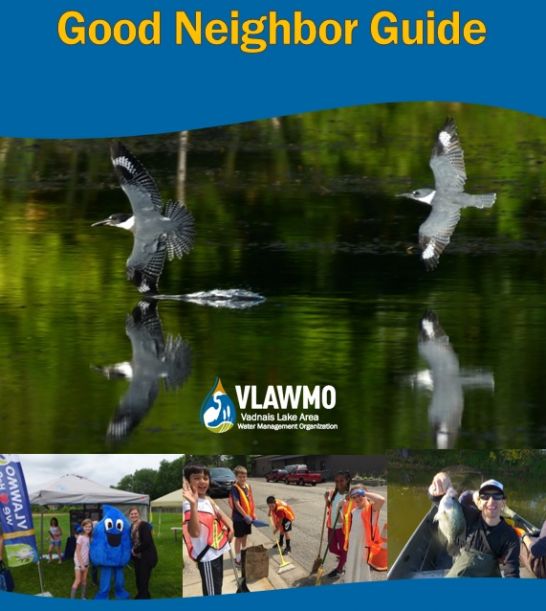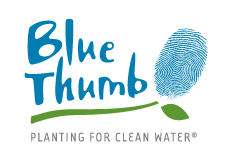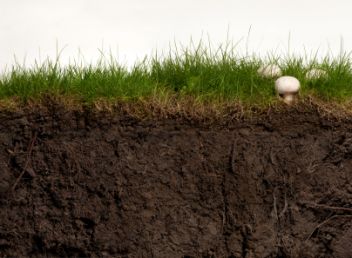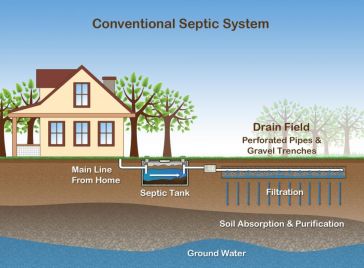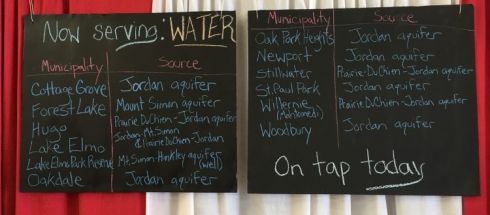WATER STEWARDSHIP AT HOME
Residents can help support lakes, wetlands, and streams from home. Check out these tips and resources to help plan ahead, beautify the yard, reduce overall maintenance time, and improve the watershed for the future. We've outlined four goals (in no particular order) to approach yard care with the watershed in mind:
Reduce runoff volume:
The introduction of pavement, rooftops, and other impermeable surfaces creates new challenges and shortcuts in the water cycle. The more water travels, the more it picks up contaminants and debris, and the less it replenishes groundwater. A single family home can generate thousands of gallons of runoff each year, but by catching water where it falls, we can help reduce stress on lakes, streams, and wetlands.
Downspouts: Direct downspouts into grassy areas instead of onto pavement. This can be an easy fix in areas with no basement, or could mean extending a downspout. 10' is the recommended distance between a drainage point and a home foundation.
Store water closer to where it falls: Consider installing a raingarden or bioswale to retain runoff, infiltrate it into the ground, and help reduce drainage burdens for downstream neighbors. These projects are designed to hold water up to 48 hours - a valuable timeframe for water retention and not enough time for ponding or mosquito propagation. Basins and temporary holding areas should be 10' or more from basement foundations. In many cases, creating space for water to infiltrate is both an asset to the watershed and a way to consolidate and manage wet areas. In many cases, there are better alternatives than turf for managing wet areas. Visit our grant programs page to learn how VLAWMO can help fund a project on your property.
Downspouts and runoff storage
Reduce nutrients in runoff:
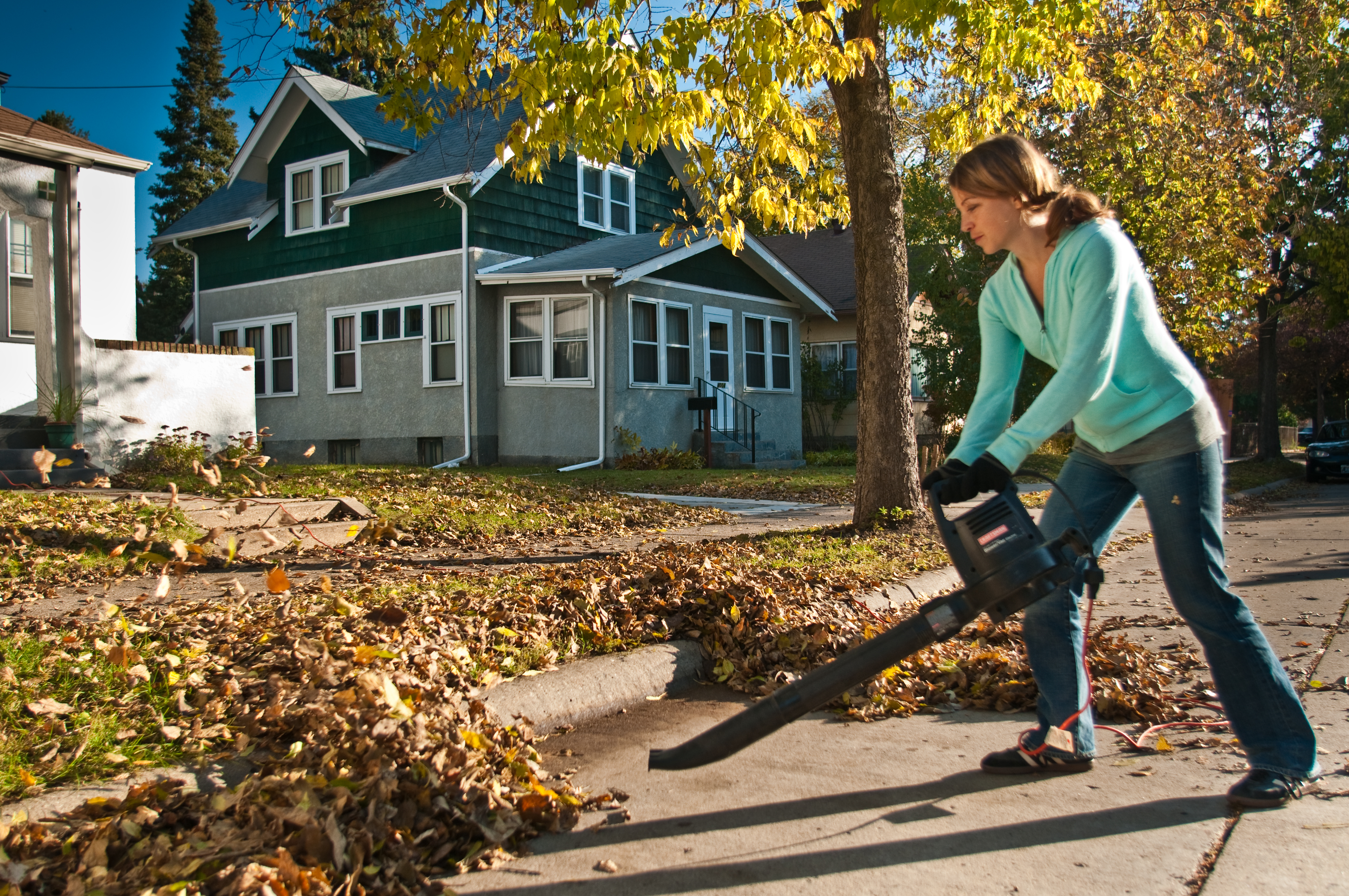 Photo: Clean Water MN
Photo: Clean Water MN
Excess nutrients is one of the main causes of poor water quality in the metro, causing strong algae blooms, murky water, and degraded aquatic habitat. To keep excess nutrients out of lakes and wetlands, we must help them stay up on the landscape.
Grass clippings: Direct grass clippings away from the street. This can easily be accomplished by keeping the spray side of the mower (typically the right side) pointing away from pavement for 2-3 passes around the perimeter. Mulch grass clippings into the lawn for free fertilizer, or dispose of them at a designated yard waste compost site or through a yard waste curb side hauler service.
Clean pavement: Sweep or use a blower to keep leaves, grass clippings, and fertilizer out of the street and off of pavement. Grass clippings and mulched leaves act as free fertilizer when left on the lawn. Don't wash-off fertilizer spills with a hose - sweep or vacuum and dispose in the trash.
Car Washing: Home car washes are convenient, but send soap, oil, salt, and excess mud to a lake or wetland. Visiting a commercial car wash helps by sending the dirty wash water to a treatment plant. When cars or trucks are especially muddy and need heavy washing, doing so on the lawn or using rolled-up towels across the driveway are easy ways to reduce debris going into runoff. Be sure to fix automotive leaks promptly, as these also wash into waterbodies with stormwater.
Fertilize smart: Fertilize according to a professional soil test such as the U of M soil lab, which lasts for several years. If you must fertilize, do so around Labor Day. At this time grass is avidly storing nutrients for winter. This helps reduce the amount of fertilizer that runs off the lawn. Select a slow-release fertilizer or as high of a percentage of slow-release you can find to help keep the application on the soil where it's intended. Avoid weed-and-feed mixes, as these tend to increase misapplication, runoff, and chemical drift, and the two materials are best applied at different times of the year. Leaving grass clippings on the lawn also serves as a source of fertilizer - if the lawn isn't irrigated and watering is low to moderate, one year's worth of grass clippings is estimated to be about the same as a single application of synthetic fertilizer. Never fertilize when grass is dormant or when temperatures are below 50° F, as the nutrient will likely be lost into the air or nearby waterbodies.
Dispose of yard waste responsibly: Avoid dumping yard waste such as leaves and grass clippings into ditches and wetlands. Although they're natural material and seem innocent, grass clippings, leaves, and yard waste become pollutants in water bodies. Dumping into ditches and wetlands clogs drainage ways, encourages algae blooms, smothers plant life that would otherwise assist soil and water health, and creates a need for expensive dredging. The resulting soil conditions are a nearly permanent impact that also is more conducive to spreading invasive species. Instead, dispose of yard waste through a licensed hauler service or at a designated county compost facility. Dumping any material into a storm drain is an illegal illicit discharge.
Pick-up pet waste: Although seemingly innocent and minuscule, both the Environmental Protection Agency (EPA) and the Minnesota Pollution control Agency (MPCA) have placed pet waste in the same category of water contaminants as toxic chemicals and oil. Excess nutrients become pollutants, and the increased pet density in urban and suburban areas create a higher density of nutrient pollution. According to the EPA, the average dog discards about three quarters of a pound of waste per day. With this, 100 average sized dogs can produce up to 75 lbs of waste annually, 2,250 monthly, and 27,000 lbs annually. Pet diets are also high in protein, unlike geese and deer, which leads to a nutrient-dense waste that can take over a year to fully break down. In addition to nutrients, pet waste also carries coliform bacteria, ringworm, roundworm, salmonella, giardia, and other contaminants. Parks and yards with turf grass and compacted soil are more conducive to shedding runoff and picking-up contaminants. Waiting and letting pet waste sit increases the chances for contaminants to runoff the surface as its breaking down. Pet waste should be disposed of in the trash or the sanitary sewer system - but never in stormdrains, ditches, or compost. Prompt pick-up routines are the most responsible option for the watershed and for the community.
Fertilizing, grass clippings, car washing, yard and pet waste
Reduce erosion and sedimentation:
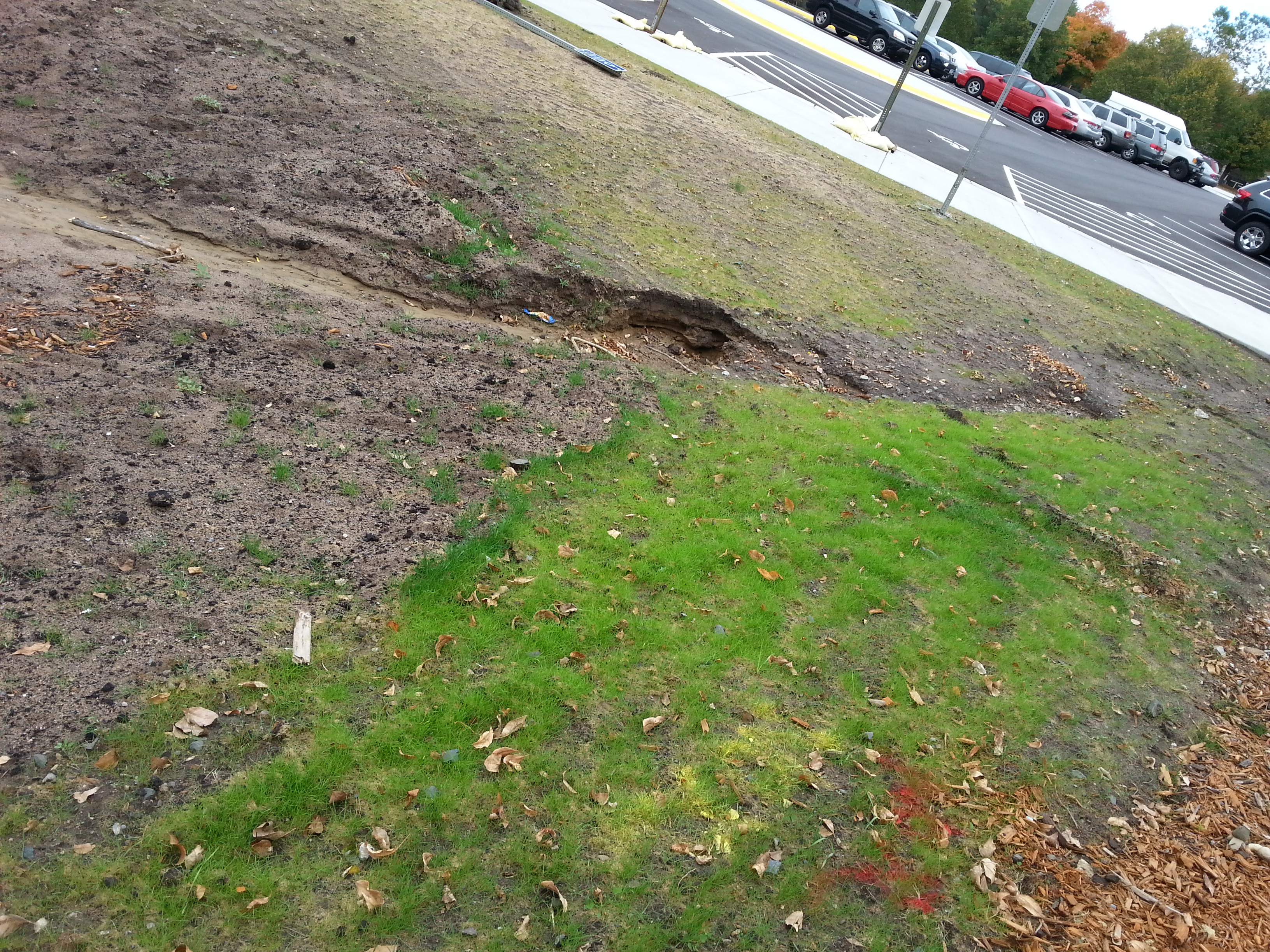
Sand and soil particles are constantly on the move. As the landscape changes though, the rate at which soil moves can increase, and the end destination is usually a water body. Faster runoff can lead to increased erosion. By covering bare soil and maintaining healthy upland vegetation, we can prevent water from picking up speed, and prevent water bodies from being choked out with sediment. This also helps keep ditches and storm drain systems functioning efficiently, and reduces the amount of contaminants that stick to sediment (oil, antifreeze, automotive brake dust, fertilizers, excess nutrients, etc.). To help reduce erosion and sedimentation into water bodies:
Mowing height: Maintain a mowing height of 3-5". This reduces erosion and evaporation on the lawn by allowing grass to shade the soil and grow deeper, more stable roots. Deeper roots allow the soil to hold more water before it gets saturated, making it more versatile to both wet and dry extremes.
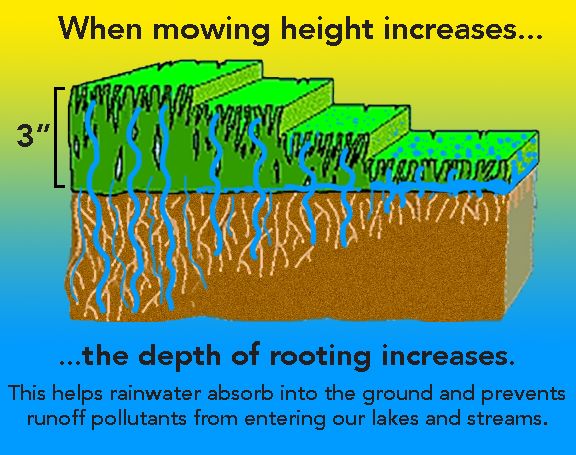
Mowing light: Cut only 1/3 of the blade at a time. Even if the lawn was neglected for a time, cutting more than 1/3 of the blade to make up for lost time stresses the grass. Stressed grass spends its energy recovering, which makes it more vulnerable to problems, less able to recover from drought, and less able to bounce back after dormancy.
Cover bare soil: Be attentive to bare soil and cover it quickly with sod, shrubs, overseeding, or an arranged planting. When dried out from wind or sun exposure, soil it is more susceptible to erosion.
Stabilize: Place boulders or trap rock in spots with high velocity runoff. This slows down runoff and gives it time to soak into the ground, disperse, and reduce soil damage. Sometimes regrading a slope is needed.
Try longer standing vegetation: Prior to European settlement, perennial vegetation worked as infrastructure for the water cycle (prairie, wet meadow, oak savannah, etc.). Prairie and wet meadows move water slowly, filter it, and store it to reduce downstream impacts. While conventional lawns have their advantages for recreation and play, places with different uses should consider alternative ground covers other than turf grass. Where feasible, features such as deep-rooted native plants, lo-mow lawns, bee lawns, sedge or native bunch grass ground covers, prairie, and shoreline restorations are an asset to both homeowners and the watershed. Low-traffic and hard to maintain places such as slopes often benefit from a different strategy that's either an alternative lawn or a blend of conventional and alternative. Visit our cost-share web page to learn more about these types of projects and to get funding for a project of your own. See the Blue Thumb link (right) for more on native plants.
Click here for tips on backyard soil health
Mowing, plant and groundcover selection
Conserve water:
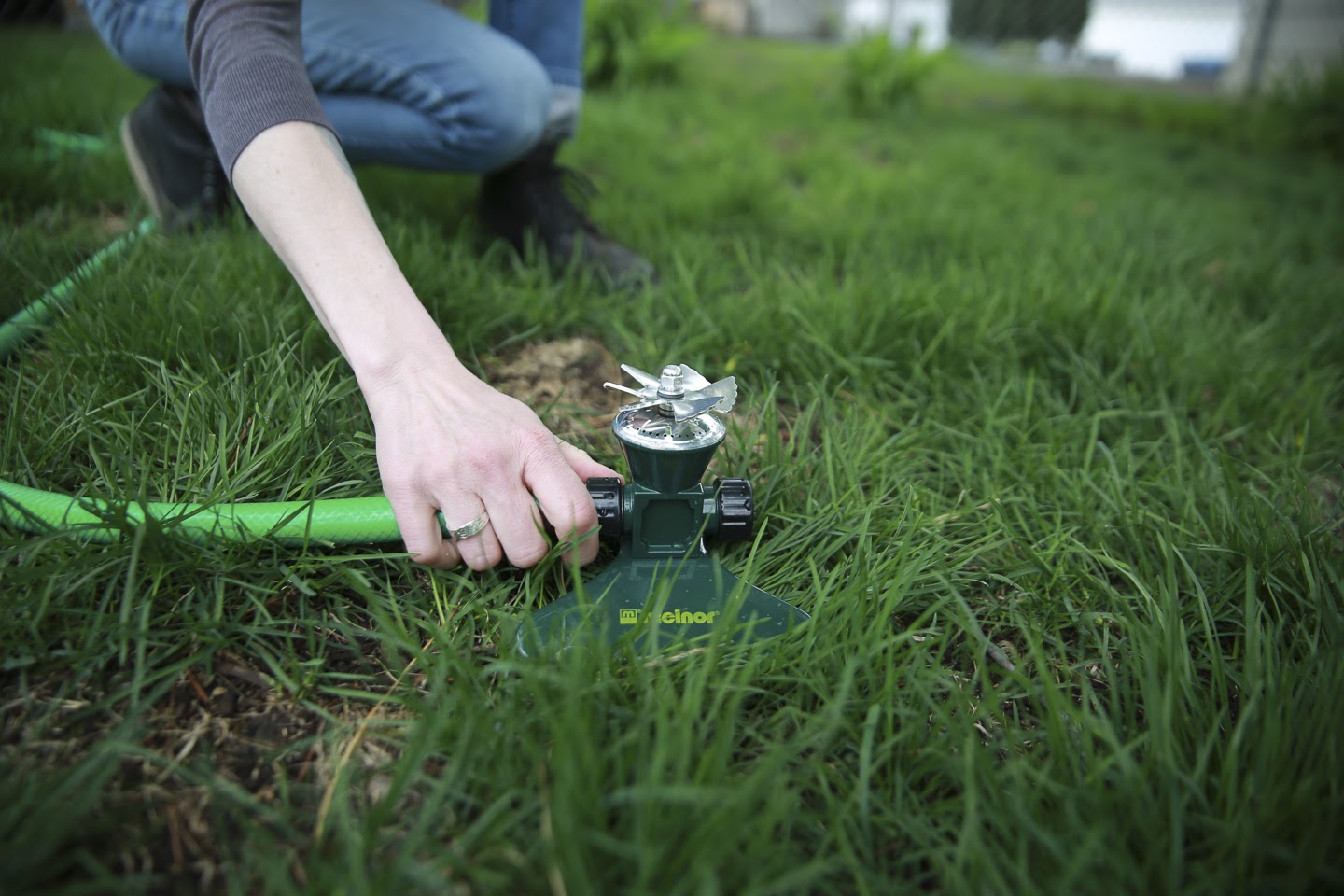 Photo: Clean Water MN
Photo: Clean Water MN
Keep water off the pavement: Set sprinklers and irrigation systems so that they don't spray onto pavement. Fix errant sprinkler heads that are spraying onto pavement or contact an irrigation professional to request a fix.
Timing: Water plants and grass early in the morning or in the evening to reduce evaporation.
Water just enough: Account for rainfall in weekly watering. According to the U of M, turf grass only needs 1" of water per week. When dormant, turf typically doesn't require any watering. In many cases, municipal odd/even watering bans encourage more watering than necessary due to the assumption that watering must occur on certain days.
Shorter sessions: Divide typical lawn watering time in half, and water twice. Two short sessions prevent saturation, which causes less water to run off the lawn. A few hours between watering sessions helps the lawn hold and absorb the water. For trees and shrubs, deeper watering sessions are recommended.
Keep it on the down-low: Select sprinklers that reduce evaporation and wind drift. These are sprinklers that keep water low to the ground and disperse water in a stream rather than a mist.
Know when you're overboard: Watch for over-watering. Grass that's mushy underfoot, has a musty odor, or sprouts excessive mushrooms or mold are signs of this issue.
Stay sharp: Avoid a "set it and forget it" strategy. As seasons change, rain patterns change. Adjust irrigation systems weekly according to rainfall, and cut back on days of watering as temperatures decrease. Consider smart irrigation systems that account for rainfall and water at the best times of day automatically.
Take a load off: Turf grass is adapted for dormant periods in both the winter and hot summer months. Consider allowing a brown, dormant look at this time and turf will green up again when rain returns. Just a 1/2 inch of water every 2-3 weeks will keep the turf alive yet dormant. With the lack of growth, mowing can take a break. It is advised to keep turf in a single summer dormant period rather than switch in and out of dormancy multiple times in the growing season.
Mowing Height Impacts Water Use: Encourage deeper turf roots by maintaining a higher mowing height (3-5”). Root investment early in the year will be an asset later in the year, creating a less finicky lawn that retains more moisture and reduces the need for watering. This is especially the case for dry months and drought. View our turf growth graphic for more insight.
Store and re-use: Install a rainbarrel to re-use rainwater on garden plants. VLAWMO will reimburse 50% of a rainbarrel for residents in the watershed - visit our grant programs to learn more.
Resources:
Turf and irrigation: U of M presentation
Water Conservation Brochure: Saint Paul Regional Water Services
Watering Wisdom: Webinar series
Green Grass with Less Blue: Video
Fine fescue lawn: U of M Extension
Help out in a Drought: Apartments and condos
Help out in a Drought: Residents and home owner's associations
Help out in a Drought: Lawn maintenance and irrigation professionals
Irrigation, mowing, rainbarrels
Other ways to help:
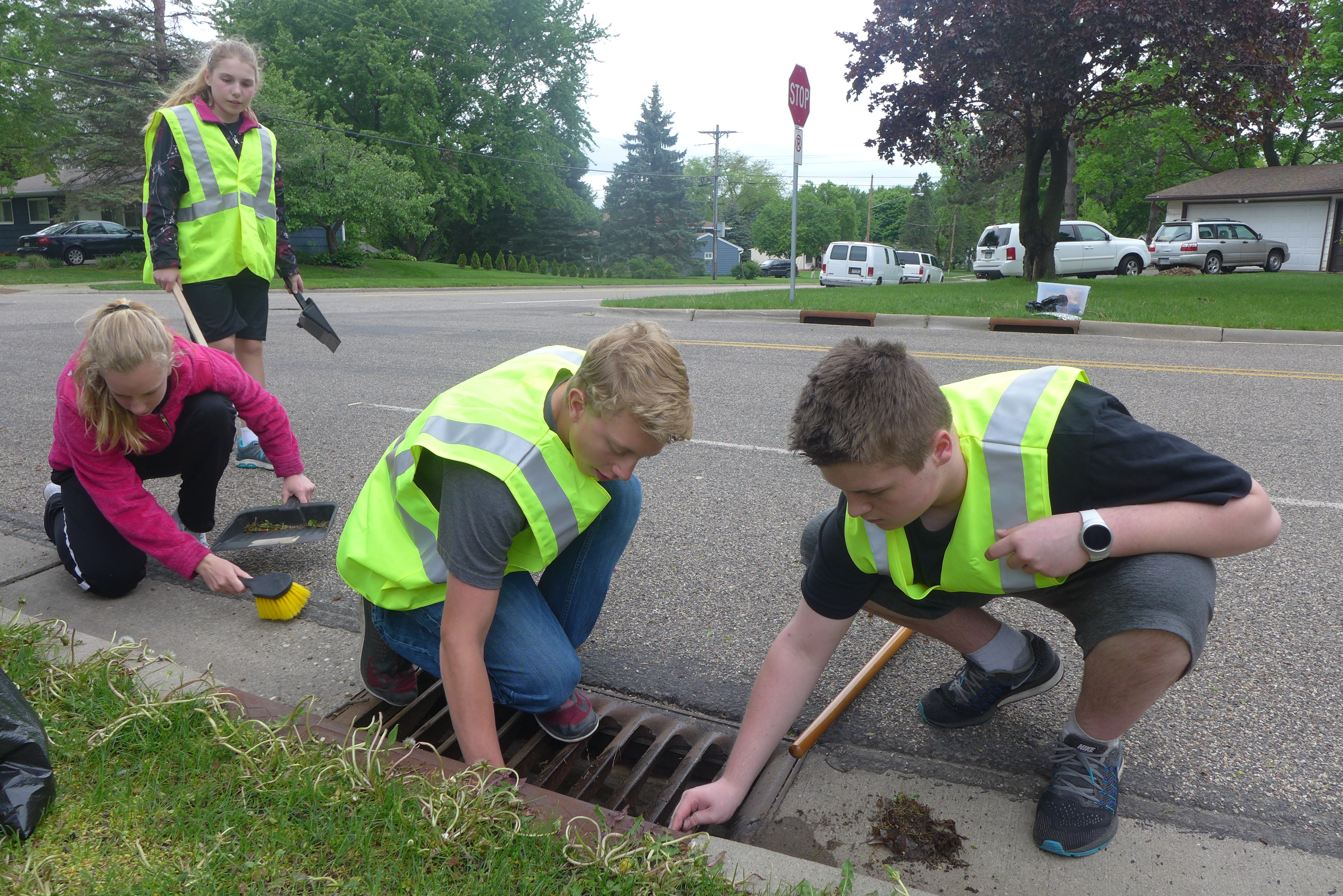
- Help prevent illicit discharge: Illicit discharge is anything that isn't stormwater or snow melt. Inform family and friends that it is illegal to use stormdrains and ditches as a disposal site or waste receptacle, and call your City or Township's engineering or public works department to report a suspected illicit discharge. Learn more with this illicit discharge video.
- Herbicides: Apply responsibly: 1) Practice spot-treatment instead of blanket treatment. 2) Apply when there's no wind, low humidity, and ensure that product fully dries before precipitation occurs. 3) If you must treat broadleaf weeds, do so in the fall at the first frost. This is the time broadleaf weeds are preparing for winter, and will thus take in the herbicide fully. Other times such as June may hinder the plant temporarily, but they will still grow back. The patience to wait makes a single treatment more effective. 4) Consider letting perennial weeds such as dandelion flower, then mow the tops off when flowering is complete. 5) Never apply an herbicide with surfactant near water.
- Insecticide: Apply responsibly: 1) Only for specific pest problems that are a hinderance to quality of life 2) Only if a non-insecticide option isn't available.
- Pet waste: Pet waste contains harmful bacteria and pathogens, and is dense in nutrients. When it runs off of surfaces such as pavement or even turf, it raises risks for harmful contamination and excessive algae growth in waterbodies. The issue of pet waste is compounded in urban areas, which contain large pet populations in a concentrated area. Pet waste should always be picked-up promptly and disposed of either in the trash or the sanitary sewer system. More on pet waste pollution prevention can be found at the MPCA.
- Adopt a stormdrain: Adopting one or several nearby stormdrains is an easy, practical way to make a difference for water quality. Visit adopt-a-drain.org to find your drain, give it a name, and get started with watershed protection.
- Adopt a raingarden: For garden and outdoor enthusiasts, helping maintain a public raingarden keeps our projects functioning and looking great for the community. Each raingarden or bioswale has a team of volunteers, and small, frequent maintenance is both more convenient and the most effective method of maintenance. Visit our service opportunities page to get plugged-in.
- Build your own raingarden, native planting, shoreline restoration, or permeable pavement project with financial and planning help from VLAWMO. Check out our neighborhood spotlights for inspiration!
Connecting the yard to the watershed, herbicides and insecticides
Illicit Discharge is illegal dumping
The Cities and Townships in the VLAWMO watershed facilitate an illicit discharge detection and elimination (IDDE) program. An illicit discharge is any substance that's not stormwater or snow meltwater. The IDDE program strives to ensure that only stormwater and snow meltwater go into a stormdrain system or ditch drainage system. Because stormdrains and ditches send stormwater runoff and snowmelt directly to a receiving waterbody untreated, it's important to plan for proper disposal of chemicals, furniture, paints, and other household materials.
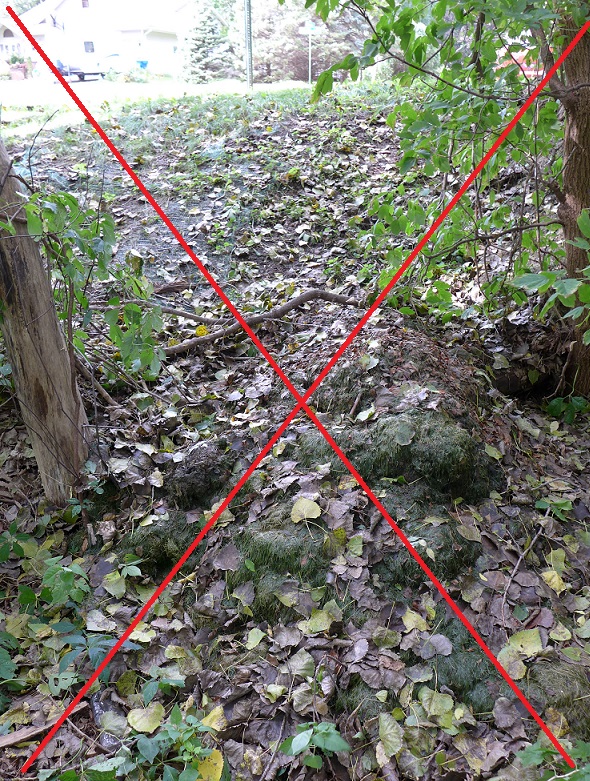
What should not go into stormdrains, ditches, or wetlands:
- Motor oil and grease
- Construction material such as concrete or drywall debris
- Construction site sediment
- Water softener salts
- Antifreeze
- Cleaners, paints, and solvents
- Furniture such as unwanted couches or mattresses
- Grass clippings
- Leaves and other yard debris
- Scrap metal
- Pet waste - This should also be removed from surfaces such as pavement and turf to prevent runoff into stormdrains and waterbodies
These items harm our local wetlands, streams, and lakes, and cost taxpayers money for clean-up and remediation.
Leaves and grass clippings are "natural," but when dumped into ditches or wetlands cause an excess of nutrients that feed algae blooms, create conditions that cater to undesired or invasive vegetation, hinder the efficient movement of water on the surface and into the soil, and cost taxpayers an extra burden for clean-up and maintenance.
What should go into stormdrains, ditches, or wetlands:
- Stormwater runoff: "Only rain down the drain"
- Snowmelt
Exceptions for inputs into stormdrains and ditches, with special consideration:
- Clean water discharges including water line flushing
- Air conditioning condensation
- Irrigation water: Strive to prevent irrigation from spraying directly onto pavement, and discontinue watering if turf is saturated and shedding water
- Sump pump discharge: Let run across a vegetated surface before discharging into street or stormdrain
- De-chlorinated swimming pool water: Let water sit idle for one week before discharge, run across vegetated surface before discharging into street or stormdrain
- Discharges or flow from firefighting and other activities necessary to protect public health and safety
Planning for Responsible Disposal:
In many cases, the responsible choice for yard waste disposal isn't an instant result. Because of this, a bit of patience and some upfront research is needed to be prepared before the need for disposal arises. Once prepared, disposal becomes convenient, easy, and more responsible for the community. Check out a county disposal guide for tips and resources on specific items, or call the hazardous waste disposal department if your item isn't listed.
Disposal guides:
Reporting an illicit discharge:
Accountability is a community effort. If you see or suspect an illicit discharge based on observation or evidence, please report it to your City or Township's engineering department. For county roads and properties, contact one of the county representatives below.
- Vadnais Heights: (651) 204-6050
- Lino Lakes: (651) 982-2455
- North Oaks: (651) 792-7765
- White Bear Lake: (651) 429-8531
- White Bear Township/Gem Lake: (651) 747-2777
- Ramsey County: (651) 266-7162
- Anoka County: (763) 862-4213
Water Stewardship in the Home:
Use the fridge: Keep a pitcher of water in the refrigerator to reduce run time as water gets cold.
Fix leaks: Leaky sinks, toilets, and pipes can waste up to 90 gallons of water each day.
On/off control: Keep water off when brushing teeth, use when needed.
Dishes: Only run a full load of dishes. Skipping the extra rinse is often adequate and saves water.
Simple tools: Install faucet aerators and low-flow shower heads.
Shop smart: Watch for the WaterSense logo when purchasing devices and home appliances.
Learn about salt and softening: Visit the MPCA Water Softening page for tips on how to manage your home water softener with water quality in mind. Small amounts of leftover water softening salt should be disposed of in the trash. Visit Ramsey County's disposal guide for more on water softeners: Water Softeners.
More tips on in-home water use:
How-to Videos:
VLAWMO videos:
- Neighborhood Spotlight: Managing Stormwater Runoff from Home
- Turf Talk Part 1: Irrigation and Variety Selection
- Turf Talk Part 2: Variety Selection and Fescues
- Fall Lawn Care
- Winter Maintenance - Teamwork for Clean Water
- Watersmart Landscaping
- Find more videos at the VLAWMO Youtube page
Other videos:
Downloads:
Using Salt Wisely: Flyer
Salt Pollutes our Water: Picture
Smart Salting for Clean Water: Poster
Clean Water Landscaping: Poster
Practical Plantings: Simple ground covers and bulky, unified plantings to help fill space. A great way to plant in hard to reach or hard to mow places when complexity isn't of interest.
Wet Soil Specialists: Plants to help wet areas appear intentional, avoid die-off from inundation, and benefit wildlife
Links, Resources, and Partners:
Blue Thumb: Native plant selection tools
__________________________________
Clean Water MN: Twin Cities water blog, clean water tips
__________________________________
Freshwater: Programs, events, news, and weather calendars
__________________________________
MPCA: State reports, programs, and publications
__________________________________
University of Minnesota Soil Testing Lab: Schedule a soil test
__________________________________
Septic System Resources
__________________________________
East Metro Water: Tips and Tales about Keeping Water Clean
 Contact us
Contact us
Phone: (651) 204-6070
Fax: (651) 204-6173
Email: office@vlawmo.org


